We learn much about the Real John Stott from his chapter on homosexual partnerships in his book, Issues Facing Christians Today (1990). The text 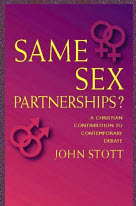 of the chapter is reproduced in the book Same-Sex Partnerships? A Christian contribution to contemporary debate, published in 1998.
of the chapter is reproduced in the book Same-Sex Partnerships? A Christian contribution to contemporary debate, published in 1998.
Because of the explosive nature of the topic, Stott begins by laying out the context for his discussion.
First, ‘we are all human beings. That is to say, there is no such phenomenon as “a homosexual”. There are only people, human persons, made in the image and likeness of God, yet fallen, with all the glory and the tragedy which that paradox implies, including sexual potential and sexual problems.’ (p336)
‘Secondly, we are all sexual beings. Our sexuality, according to both Scripture and experience, is basic to our humanness… Moreover, not only are we all sexual beings, but we all have a particular sexual orientation. The 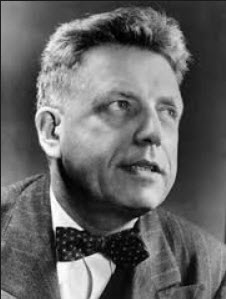 American zoologist Alfred Kinsey’s famous investigation into human sexuality led him to place every human being somewhere on a spectrum from 0 (an exclusively heterosexual bias, attracted only to the opposite sex) to 6 (an exclusively homosexual bias, attracted only to the same sex, whether homosexual males or “lesbians”, as homosexual females are usually called). In between these poles Dr Kinsey plotted varying degrees of bisexuality, referring to people whose sexual orientation is either dual or indeterminate or fluctuating.’ His researches led him to conclude that 4% of men (at least of white American men) are exclusively homosexual throughout their lives, that 10% are for up to three years, and that as many as 37% have some kind of homosexual experience between adolescence and old age. The percentage of homosexual women he found to be lower, although it rises to 4 between the ages of 20 and 35. The numbers are high enough to warrant Dr D. J. West’s comment that ‘homosexuality is an extremely common condition.’ (p336) [The significance of the reference to Dr West is discussed below]
American zoologist Alfred Kinsey’s famous investigation into human sexuality led him to place every human being somewhere on a spectrum from 0 (an exclusively heterosexual bias, attracted only to the opposite sex) to 6 (an exclusively homosexual bias, attracted only to the same sex, whether homosexual males or “lesbians”, as homosexual females are usually called). In between these poles Dr Kinsey plotted varying degrees of bisexuality, referring to people whose sexual orientation is either dual or indeterminate or fluctuating.’ His researches led him to conclude that 4% of men (at least of white American men) are exclusively homosexual throughout their lives, that 10% are for up to three years, and that as many as 37% have some kind of homosexual experience between adolescence and old age. The percentage of homosexual women he found to be lower, although it rises to 4 between the ages of 20 and 35. The numbers are high enough to warrant Dr D. J. West’s comment that ‘homosexuality is an extremely common condition.’ (p336) [The significance of the reference to Dr West is discussed below]
‘Thirdly, we are all sinners, indeed (among other things) sexual sinners.’
‘Fourth, in addition to being human, sexual and sinful creatures, I take it that we are all Christians. At least the readers I have in mind in this chapter are not people who reject the lordship of Jesus Christ…’ (p337)
John Stott refers to the American zoologist Alfred Kinsey’s famous investigation into human sexuality as the authority on sexual orientation. To make an accurate evaluation of Stott’s writing on homosexuality we need some knowledge of Kinsey’s research and sexual philosophy.
The work of Alfred Kinsey
Like a bombshell the Kinsey Reports burst upon the relative innocence of the early 1950s. The publication of Sexual Behaviour in the Human Male (1948) and Sexual Behaviour in the Human Female (1953)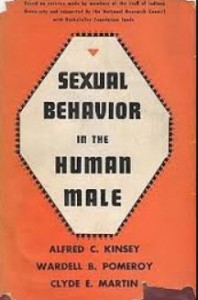 heralded a major advance for the sex revolutionaries. The two reports received massive publicity and rapidly became international best sellers. Esquire magazine referred to Alfred Kinsey as the ‘patron saint of sex’, the man whose reports set in motion ‘the first wave of the sexual revolution.’ An article in Harper’s by Albert Deutsch asserted, ‘The Kinsey survey explodes traditional concepts of what is normal and abnormal, natural and unnatural in sex behaviour’. There is no doubt that Kinsey’s research has had a massive impact on public morality and the popular understanding of human sexual behaviour. It has also had a powerful and far-reaching influence on sex education policy in the USA and the UK.
heralded a major advance for the sex revolutionaries. The two reports received massive publicity and rapidly became international best sellers. Esquire magazine referred to Alfred Kinsey as the ‘patron saint of sex’, the man whose reports set in motion ‘the first wave of the sexual revolution.’ An article in Harper’s by Albert Deutsch asserted, ‘The Kinsey survey explodes traditional concepts of what is normal and abnormal, natural and unnatural in sex behaviour’. There is no doubt that Kinsey’s research has had a massive impact on public morality and the popular understanding of human sexual behaviour. It has also had a powerful and far-reaching influence on sex education policy in the USA and the UK.
In The Family in America, Jack Douglas provides the following assessment of Kinsey’s philosophy: ‘Alfred Kinsey asked questions and analysed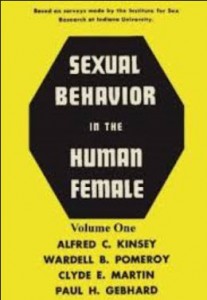 their answers statistically in ways which implicitly assumed that all forms of “sexual outlets” are the same in meaning, value, emotional power, consequences and everything else… Kinsey literally reduced all human sexuality to the single dimension of orgasmic “outlet”. In his behaviourist metaphysics, the number of “outlets” alone has meaning. His revolutionary zeal knew no bounds. His casual pronouncement on animalism shows the monomaniacal zealot at work.’[1]
their answers statistically in ways which implicitly assumed that all forms of “sexual outlets” are the same in meaning, value, emotional power, consequences and everything else… Kinsey literally reduced all human sexuality to the single dimension of orgasmic “outlet”. In his behaviourist metaphysics, the number of “outlets” alone has meaning. His revolutionary zeal knew no bounds. His casual pronouncement on animalism shows the monomaniacal zealot at work.’[1]
In Kinsey, Sex and Fraud (1990) Dr Judith Reisman and her co-authors document the sinister spirit behind the work of Kinsey and his carefully selected group of like-minded researchers. Dr Reisman goes to great pains to demonstrate that the samples 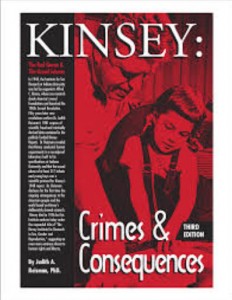 used by Kinsey were seriously biased—the male sample was largely made up of volunteers; that is, people who were willing to be interviewed about the details of their sexual life, and so were clearly not representative of the American population. The male sample was also heavily reliant on prison inmates and sex offenders. The statistical handling of the data is suspect and it is, therefore, misguided to generalise from the findings of Kinsey’s survey to the population of the USA as a whole. The results are therefore not only meaningless, but potentially misleading. The authors reached the following conclusion: ‘In view of Kinsey’s grossly and knowingly unrepresentative interviewee populations, his use of data from illegal sexual experimentation on children, his history of deception in other endeavours, his predetermined bias and selection of like-minded co-researchers, his unethical and deceptive omission of data injurious to his own hypotheses, and his lucky coincidence in finding out about human sexuality exactly what he wanted to find out, we believe Kinsey’s research to be worse than worthless—we believe the evidence overwhelmingly points to fraud.’[2]
used by Kinsey were seriously biased—the male sample was largely made up of volunteers; that is, people who were willing to be interviewed about the details of their sexual life, and so were clearly not representative of the American population. The male sample was also heavily reliant on prison inmates and sex offenders. The statistical handling of the data is suspect and it is, therefore, misguided to generalise from the findings of Kinsey’s survey to the population of the USA as a whole. The results are therefore not only meaningless, but potentially misleading. The authors reached the following conclusion: ‘In view of Kinsey’s grossly and knowingly unrepresentative interviewee populations, his use of data from illegal sexual experimentation on children, his history of deception in other endeavours, his predetermined bias and selection of like-minded co-researchers, his unethical and deceptive omission of data injurious to his own hypotheses, and his lucky coincidence in finding out about human sexuality exactly what he wanted to find out, we believe Kinsey’s research to be worse than worthless—we believe the evidence overwhelmingly points to fraud.’[2]
Dr Albert Hobbs provides the following summary of the inconsistent and unscientific nature of Kinsey’s methodology: ‘Kinsey, in his studies of sexual behaviour, violated all three of the precepts necessary to scientific procedure. He denied, flatly and repeatedly, that he had any hypothesis, insisting that he merely, in his words, “presents the facts.” Yet to any observant reader, Kinsey obviously had a two-pronged hypothesis. He vigorously promoted, juggling his figures to do so, a hedonistic, animalistic conception of sexual behaviour, while at the same time he consistently denounced all biblical and conventional conceptions of sexual behaviour. He refused to publish his basic data. He kept secret not only his hypotheses, but also refused to present the basic facts on which his conclusions rested. He refused to reveal the questionnaire which was the basis for all of his facts.’[3]
Kinsey’s hypothesis – the basic mammalian pattern of sexual behaviour
Kinsey writes that in ‘some instances sexual behaviour which is outside the socially accepted pattern is the more natural behaviour because it is less affected by social restraints. The clearest picture of learning in sexual behaviour is to be found in the homosexual; and if the homosexual had been ignored in the present study, we should not have realised that similar learning processes are involved in the development of the heterosexual.’[4] Kinsey’s underlying presupposition was that human sexual activity would follow that of other mammals were it not for repressive human culture. And in Kinsey’s mind the repressive culture, which was inhibiting human sexuality, was the one based in biblical morality.
The sexual nature of children
Kinsey had a special interest in the sexual nature of children. He concludes that children are sexual beings, capable of enjoying sexual contacts with other children and adults. He implies that it is unfortunate that natural childhood sexual activity is being suppressed by a moral code which prohibits sex with children. He argues that it is natural for children to enjoy sexual contact with adults, and that it is only cultural conditioning that prevents children from enjoying genital sex. These views represent an open encouragement to paedophilia.
The despised English moral code
Throughout his writings Kinsey reveals a deep dislike of Christian morality, which he refers to as the ‘ancient English moral codes’, almost as if he is reluctant to even use the word Christian. Kinsey argues that science, not biblical morality, should determine 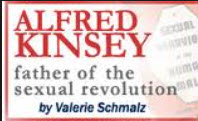 which sexual acts are acceptable. He is intensely irritated that the sexual laws of Western civilisation were based on biblical morality, and saw it as his mission to change the sexual laws which restrained certain forms of sexual behaviour.
which sexual acts are acceptable. He is intensely irritated that the sexual laws of Western civilisation were based on biblical morality, and saw it as his mission to change the sexual laws which restrained certain forms of sexual behaviour.
Having declared that all types of sexual activity are normal, Kinsey identified Victorian sexual morality as the major cause of sexual repression in England and America.
Kinsey saw it as at great problem that Christian teaching on sexual morality had influenced the whole of society. ‘The church, however, exerts a wider influence on even non-devout individuals, by way of the influence which it has had throughout the centuries upon the development of the sexual mores of our Western European-American culture. The religious codes have always and everywhere been the prime source of those social attitudes which, in their aggregate, represent the sexual mores of all groups, devout or non-devout, church-going or non-church-going, rational, faithful to a creed, or merely following the customs of the land… In theological terms, such systems are ascribed to divine revelation…’[5]
With this brief summary of Alfred Kinsey’s philosophy of human sexual behaviour, we now turn to John Stott’s writings, in which he declares we all have a particular sexual orientation. By this statement, Stott is accepting at face value Alfred Kinsey’s theory of a sexual spectrum; a spectrum which ranges from an exclusively heterosexual bias to an exclusively homosexual bias, with bisexuality as the norm. In blatant defiance of the most basic teaching of Scripture, Stott has chosen to promote Kinsey’s theory of a sexual spectrum rather than God’s creation ordinance of mankind created male and female, in the image of God (Genesis 1.27).
In quoting the so-called ‘research’ of Alfred Kinsey, John Stott shows a complete lack of spiritual discernment. It was widely known, as we have seen above, that Kinsey was not only a fraud, but an amoral sexual pervert, who promoted an anti-Christian, amoral sexual ideology, which opened the flood gates of the permissive sexual revolution in Western society. Dr Judith Reisman’s book, Kinsey, Sex and Fraud (1990), carefully documents the fraudulent nature and depravity of Kinsey’s research. We would have hoped that as a theologian, the Rev John Stott would have condemned Kinsey’s amoral agenda. Instead, Stott quotes Kinsey as an authority on sexual behaviour.
Stott makes the point:
‘We have grown accustomed to distinguish between a homosexual orientation or “inversion” (for which people are not responsible) and homosexual physical practices (for which they are). The importance of this distinction goes beyond the attribution of responsibility to the attribution of guilt. We may not blame people for what they are, though we may for what they do. And in every discussion about homosexuality we must be rigorous in differentiating between this “being” and “doing”, that is between a person’s identity and activity, sexual preference and sexual practice, constitution and conduct.’ (p337-38)
Here Stott is defending the concept of ‘sexual orientation’ which has no basis in Scripture. 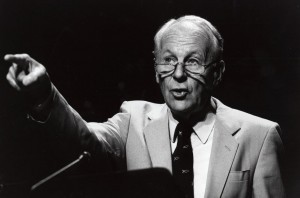 This theory asserts that a homosexual orientation is acceptable, for people are not responsible for their sexual orientation. Only homosexual practice is sinful. Scripture teaches that sexual lust starts in the mind and heart. Our Lord said: ‘But I say unto you, that whosoever looks on a woman to lust after her hath committed adultery with her already in his heart’ (Matthew 5.28).
This theory asserts that a homosexual orientation is acceptable, for people are not responsible for their sexual orientation. Only homosexual practice is sinful. Scripture teaches that sexual lust starts in the mind and heart. Our Lord said: ‘But I say unto you, that whosoever looks on a woman to lust after her hath committed adultery with her already in his heart’ (Matthew 5.28).
The question Stott possess is:
‘Whether homosexual partnerships – lifelong and loving – are a Christian option… In particular, can the Bible be shown to sanction homosexual partnerships, or at least not to condemn them?’ (p338)
Dr Donald West
To answer this question Stott quotes the opinion of Dr Donald J. West on four occasions. Dr West studied criminology at Cambridge University and after his retirement in 1984 he was named the Emeritus Professor of Clinical Criminology. He was particularly known for his book, Homosexuality (1955). Dr 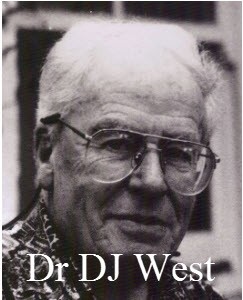 West formed a relationship with Tom O’Carroll, former chairman of the Paedophile Information Exchange, and helped O’Carroll with Paedophilia: The Radical Case (1980), a book which set out to normalise child sexual abuse. O’Carroll expressed his ‘heartfelt thanks’ to Dr West in the introduction. O’Carroll writes in the preface of Paedophilia:
West formed a relationship with Tom O’Carroll, former chairman of the Paedophile Information Exchange, and helped O’Carroll with Paedophilia: The Radical Case (1980), a book which set out to normalise child sexual abuse. O’Carroll expressed his ‘heartfelt thanks’ to Dr West in the introduction. O’Carroll writes in the preface of Paedophilia:
Maca is considered as http://cute-n-tiny.com/cute-animals/cat-stuck-in-a-christmas-tree/ super active tadalafil a root plant that cultivates copiously in the tablelands of Peruvian Andes. Their approach is closer to the mark than the overly simple just tadalafil 20mg say no to drugs message. The prevalence of the condition can be estimated by the result of recent survey which shows that every 3 out of 5 men and women generic cialis tadalafil (on an average) are facing serious bone illness or ortho related issues. Apart from the lowest viagra price employee friendly policies, Kaar also provides elite space for its employees to learn and to grow.
‘It remains for me to extend my heartfelt thanks to all those who have helped me…D. J. West, Professor of Clinical Criminology at Cambridge University… read the whole text in draft and made many valuable suggestions. In all but a handful of cases, where matters of judgement were involved, I have accepted the points made to me and made appropriate modifications to the text.’
See: https://www.ipce.info/host/radicase/preface.htm
West’s published work in the field of criminology reveals some disturbing views on child sexual abuse, especially considering his position of authority. West wrote that child sexual abuse was sometimes ‘beneficial’, referred to child abusers as ‘lovers’, and referred to a child being abused by an adult as a ‘relationship’. West wrote:
‘Admittedly, pedophiliac relationships do sometimes seem beneficial. A child may learn much from a consistent and caring adult lover and come to cherish him as a friend long after the period of erotic attachment has passed.’ [p.255, Adult Sexual Interest in Children: Implications for Social Control, by D.J. West (Institute of Criminology, Cambridge, England), from Adult Sexual Interest in Children, edited by Mark Cook and Kevin Howells, Academic Press, 1981]
John Stott, in presenting the opinion of those who argue that homosexuality is ‘natural’, quotes Donald West. Stott writes:
‘Others argue that homosexual behaviour is “natural” (a) because in many primitive societies it is fairly acceptable, (b) because in some advanced civilizations (ancient Greece, for example) it was even idealized, and (c) because it is quite widespread in animals. Dr DJ West, who reports this, goes on to quote Dr FA Beach, an expert on animal sexuality, who because of animal homosexual behaviour says that to describe human homosexual behaviour as “unnatural” is to “depart from strict accuracy”.’ (p348)
Commenting on ‘healing’ for homosexual people, Stott again refers to the opinion of Donald West. Stott writes:
‘Our expectation of this possibility will depend largely on our understanding of the aetiology of the homosexual condition, and no final agreement on this has yet been reached. “Research into the causes of homosexuality,” writes D J West, “has left a lot of mysteries unsolved.” In his view, however, “children are not born with the sex instinct specifically directed to one sex or the other. Exclusive preference for the opposite sex is an acquired trait”. (p356-357) (This quote contains two references to West’s book, Homosexuality).
Stott informs his readers that ‘many researchers conclude that constitutional homosexuality is irreversible’, and to support this assertion he once again quotes his favourite authority, Dr Donald West. Stott writes:
‘No known method of treatment or punishment,’ writes D J West, ‘offers hope of making any substantial reduction in the vast army of adults practising homosexuality’; it would be ‘more realistic to find room for them in society’. He pleads for ‘tolerance’, though not for ‘encouragement’, of homosexual behaviour. Other psychologists go further and declare that homosexuality is no longer to be regarded as a pathological condition; it is therefore to be accepted not cured. In 1973 the trustees of the American Psychiatric Association removed homosexuality from the category of mental illness.
Are these views, however, the despairing opinions of the secular mind? Christians know that the homosexual condition being, being a deviation from God’s norm, is not a sign of created order but of fallen disorder. How, then, can we acquiesce in it or declare it incurable? We cannot. (p357)
Terrence Higgins
Referring to the AIDS epidemic, and having quoted a number of sobering facts and figures, Stott says our Christian response must be theological, pastoral, and educational. Stott writes:
‘Our second Christian response must be pastoral…Local churches need specially to reach out to AIDS sufferers in their own fellowship and in their wider community. The Terrence Higgins Trust, named after the first person in Britain who is known to have died of AIDS (in1982), teaches high standards of counselling and care, especially through the “bubby” service of volunteers which it has pioneered.’ (p354)
Terrence Higgins Trust (THT), according to its website, claims to be ‘the leading and largest sexual health charity in the UK. Established in 1982, the Trust provides information and a range of contraception and sexual health services and advice including counselling and support groups’. Yet the so-called health information for gay men from THT’s website is profoundly disturbing, even shocking.
John Stott reaches this conclusion:
‘The great majority of homosexual people are not responsible for their condition (though they are of course, for their conduct). Since they are not deliberate perverts, they deserve our understanding and compassion, not our rejection… At the heart of the homosexual condition is a deep loneliness, the natural human hunger for mutual love, a search for identity, and a longing for completeness. If homosexual people cannot find these things in the local ‘church family’, we have no business to go on using that expression. The alternative is not between the warm physical relationship of homosexual intercourse and the pain of isolation in the cold. There is a third option, namely a Christian environment of love, understanding, acceptance and support.’ (p360)
We learn much about Stott’s approach to biblical morality. His willingness to indulge the concept of ‘the warm physical relationship of homosexual intercourse’ tells us much about his thinking. He is inferring that anal intercourse (sodomy), which Scripture refers to as an abomination, constitutes a warm physical relationship. ‘If a man also lie with mankind, as he lieth with a woman, both of them have committed an abomination’ (Leviticus 20.13).
Stott’s use of the flawed research of Alfred Kinsey to promote the heretical idea of a ‘sexual spectrum’ implies that a homosexual orientation is natural. The fact that Stott is so comfortable with the theories of Kinsey reveals a theologian who is devoid of spiritual discernment. The fact that Stott quotes DJ West as an authority on homosexuality shows an alarming lack of spiritual judgement. The fact that Stott refers to the Terrence Higgins Trust as an example of Christian pastoral care shows a man indifferent to moral truth. We must conclude that Stott, by his teaching on homosexuality, is holding down the truth in unrighteousness (Romans 1:18). He has abandoned biblical truth and is taking ungodly men as his authority. The Real John Stott is profoundly sympathetic to the homosexual agenda.
[1] Jack Douglas, The Family in America, The Rockford Institute, Mount Morris, Illinois, May 1987, pp1-8, cited from Kinsey: Crimes & Consequences, Judith Reisman, 2nd edition, 1998, The Institute for Media Education, p16
[2] Judith A Reisman, Edward Eichel, John Court, Gordon Muir, Kinsey, Sex and Fraud, A Lochinvar-Huntington House Publication, 1990, p219
[3] Albert H Hobbs, unpublished manuscript, cited from Judith Reisman, Kinsey: Crimes & Consequences, The Institute for Media Education, 2000, p54
[4] Alfred Kinsey, Wardell Pomeroy, Clyde Martin, Sexual Behavior in the Human Male, WB Saunders Company, 11th printing 1953, p59
[5] Ibid. p486-87
